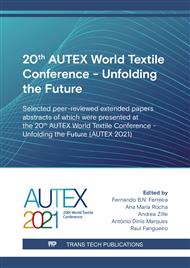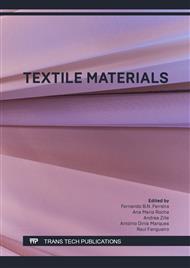[1]
Electronic Textiles: Elsevier, (2015).
Google Scholar
[2]
A.K. Yetisen, H. Qu, A. Manbachi, H. Butt, M. R. Domeci, J. P. Hinestroza, S. H. Yun,. Nanotechnology in textiles. ACS nano (2016), 10(3), 3042-3068.
DOI: 10.1021/acsnano.5b08176
Google Scholar
[3]
Myant, Vision Page – DW Page Updated - Myant. [Online]. Available: https://myant.ca/vision-page-dw-page-updated/ (accessed: Oct. 14 2021).
Google Scholar
[4]
S. Park, S. Jayaraman, Smart Textiles: Wearable Electronic Systems,, MRAS Bulletin (2003), vol. 28, no. 8, p.585–591,.
DOI: 10.1557/mrs2003.170
Google Scholar
[5]
E. Nilsson, M. Rigdahl, B. Hagström, Electrically conductive polymeric bi-component fibers containing a high load of low-structured carbon black,, J. Appl. Polym. Sci. (2015), vol. 132, no. 29,.
DOI: 10.1002/app.42255
Google Scholar
[6]
C. R. Cork, Conductive fibres for electronic textiles,, in Electronic Textiles: Elsevier (2015), p.3–20.
DOI: 10.1016/b978-0-08-100201-8.00002-3
Google Scholar
[7]
M. Kaplan, Hybrid Yarns For Thermoplastic Composites: Manufacturing Methods and Properties,, Tekstil ve Mühendis (2016), vol. 23, no. 101, p.61–79,.
DOI: 10.7216/1300759920162310106
Google Scholar
[8]
A. Bedeloglu, N. Sunter, B. Yildirim, and Y. Bozkurt, Bending and tensile properties of cotton/metal wire complex yarns produced for electromagnetic shielding and conductivity applications,, Journal of The Textile Institute (2012), vol. 103, no. 12, p.1304–1311,.
DOI: 10.1080/00405000.2012.677568
Google Scholar
[9]
A. M. Grancarić, I. Jerković, V. Koncar, C. Cochrane, F. M. Kelly, D. Soulat, X. Legrand,. Conductive polymers for smart textile applications. Journal of Industrial Textiles (2018), 48(3), 612-642.
DOI: 10.1177/1528083717699368
Google Scholar
[10]
Y. Zhang, H. Wang, H. Lu, S. Li, and Y. Zhang, Electronic fibers and textiles: Recent progress and perspective,, iScience (2021), vol. 24, no. 7, p.102716,.
DOI: 10.1016/j.isci.2021.102716
Google Scholar
[11]
İ. Borazan, M. Kaplan, and B. M. Üzümcü, Eds., Utilization of Metallic Fibers In Textiles, International Congress of Innovative Textiles. (2019).
Google Scholar
[12]
J. Slade, M. Agpaoa-Kraus, J. Bowman, A. Riecker, T. Tiano, C. Carey, P. Wilson, Washing of electrotextiles. MRS Online Proceedings Library (OPL) (2002)., 736.
DOI: 10.1557/proc-736-d3.1
Google Scholar
[13]
C. O. Baker, X. Huang, W. Nelson, and R. B. Kaner, Polyaniline nanofibers: broadening applications for conducting polymers,, Chemical Society reviews (2017), vol. 46, no. 5, p.1510–1525,.
DOI: 10.1039/c6cs00555a
Google Scholar
[14]
L. Jingcheng, V. S. Reddy, W. A. D. M. Jayathilaka, A. Chinnappan, S. Ramakrishna, and R. Ghosh, Intelligent Polymers, Fibers and Applications,, Polymers (2021), vol. 13, no. 9,.
DOI: 10.3390/polym13091427
Google Scholar
[15]
B. Krause, C. Barbier, J. Levente, M. Klaus, and P. Pötschke, Screening of Different Carbon Nanotubes in Melt-Mixed Polymer Composites with Different Polymer Matrices for Their Thermoelectrical Properties,, J. Compos. Sci. (2019), vol. 3, no. 4, p.106,.
DOI: 10.3390/jcs3040106
Google Scholar
[16]
W. Khan, R. Sharma, and P. Saini, Carbon Nanotube-Based Polymer Composites: Synthesis, Properties and Applications,, in Carbon Nanotubes - Current Progress of their Polymer Composites (2016), M. R. Berber and I. H. Hafez, Eds.: InTech.
DOI: 10.5772/62497
Google Scholar
[17]
B. Krause, C. Barbier, K. Kunz, and P. Pötschke, Comparative study of singlewalled, multiwalled, and branched carbon nanotubes melt mixed in different thermoplastic matrices,, Polymer (2018), vol. 159, p.75–85,.
DOI: 10.1016/j.polymer.2018.11.010
Google Scholar
[18]
B. Krause, R. Boldt, L. Häußler, and P. Pötschke, Ultralow percolation threshold in polyamide 6.6/MWCNT composites,, Composites Science and Technology (2015), vol. 114, p.119–125,.
DOI: 10.1016/j.compscitech.2015.03.014
Google Scholar
[19]
J. R. Bautista-Quijano, Mechanical, electrical and sensing properties of melt-spun polymer fibers filled with carbon nanoparticles,, PhD, Der Fakultät Maschinenwesen, Technischen Universität Dresden, Dresden, Germany, (2018).
Google Scholar
[20]
B. A. Weise, K. G. Wirth, L. Völkel, M. Morgenstern, and G. Seide, Pilot-scale fabrication and analysis of graphene-nanocomposite fibers,, Carbon (2019), vol. 144, p.351–361,.
DOI: 10.1016/j.carbon.2018.12.042
Google Scholar



